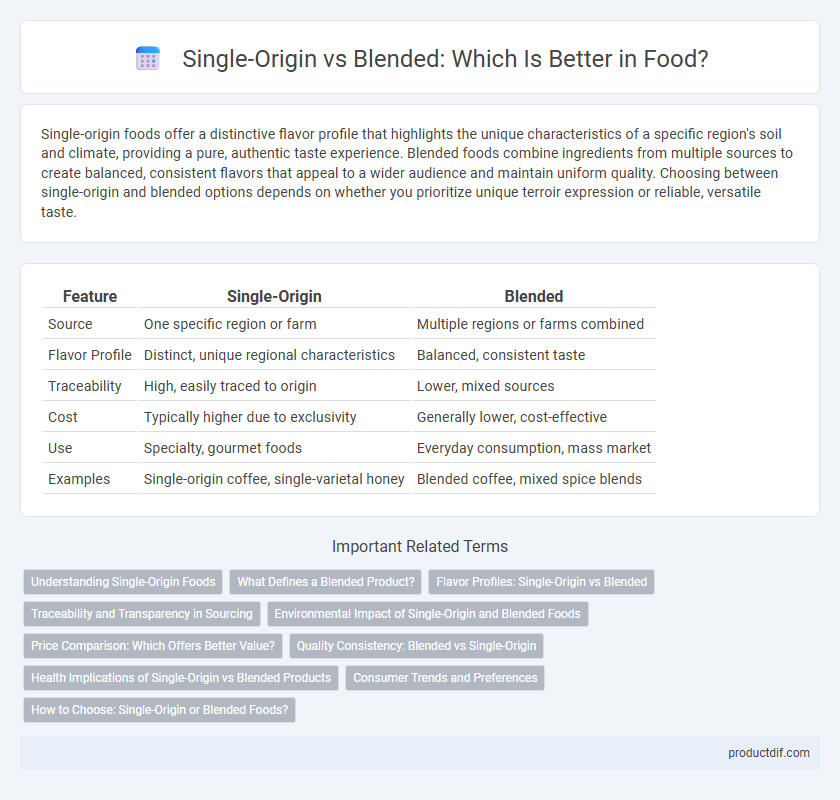Single-origin foods offer a distinctive flavor profile that highlights the unique characteristics of a specific region's soil and climate, providing a pure, authentic taste experience. Blended foods combine ingredients from multiple sources to create balanced, consistent flavors that appeal to a wider audience and maintain uniform quality. Choosing between single-origin and blended options depends on whether you prioritize unique terroir expression or reliable, versatile taste.
Table of Comparison
| Feature | Single-Origin | Blended |
|---|---|---|
| Source | One specific region or farm | Multiple regions or farms combined |
| Flavor Profile | Distinct, unique regional characteristics | Balanced, consistent taste |
| Traceability | High, easily traced to origin | Lower, mixed sources |
| Cost | Typically higher due to exclusivity | Generally lower, cost-effective |
| Use | Specialty, gourmet foods | Everyday consumption, mass market |
| Examples | Single-origin coffee, single-varietal honey | Blended coffee, mixed spice blends |
Understanding Single-Origin Foods
Single-origin foods come from a specific geographic location, such as a particular farm, region, or country, offering unique flavors influenced by local soil, climate, and cultivation methods. These products, common in coffee, chocolate, and spices, provide traceability and authenticity valued by consumers seeking high-quality and distinct taste profiles. Understanding single-origin foods helps in appreciating artisanal craftsmanship and supports sustainability by promoting regional agriculture.
What Defines a Blended Product?
A blended product combines ingredients sourced from multiple origins to achieve a consistent flavor profile and balanced quality. This approach allows producers to tailor taste, aroma, and texture by mixing various single-origin components. Blended products often provide a more accessible and affordable option compared to exclusive single-origin varieties.
Flavor Profiles: Single-Origin vs Blended
Single-origin products offer distinct and consistent flavor profiles that highlight the unique characteristics of a specific region or farm, such as fruity, floral, or earthy notes. Blended items combine various origins to create balanced and complex flavors, often aiming for smoothness, sweetness, or richness that may not be achievable with a single source. Flavor profiles in single-origin emphasize terroir and purity, while blends focus on harmony and consistency across batches.
Traceability and Transparency in Sourcing
Single-origin products offer enhanced traceability and transparency, as the sourcing of ingredients is limited to a specific geographic location, allowing consumers to verify the origin and farming practices directly. Blended products, while often combining diverse flavors from multiple regions, can complicate traceability because the exact source of each component may be less clear or undisclosed. Transparent labeling and certifications are critical in both categories to ensure ethical sourcing and inform consumers about the quality and sustainability of the ingredients used.
Environmental Impact of Single-Origin and Blended Foods
Single-origin foods often have a lower environmental impact since they are typically sourced from a specific region with sustainable farming practices, reducing transportation emissions and promoting local biodiversity. Blended foods, while potentially supporting diverse agricultural systems, can involve ingredients from multiple regions, increasing the carbon footprint due to longer supply chains and varied farming methods. Choosing single-origin options can encourage eco-friendly production and traceability, crucial for minimizing environmental degradation.
Price Comparison: Which Offers Better Value?
Single-origin coffees often command higher prices due to their unique flavor profiles and limited supply, appealing to discerning consumers seeking specialty quality. Blended coffees generally offer better value with lower costs per cup, combining various beans to balance flavor, consistency, and price. Consumers prioritizing budget may find blends more cost-effective, while those seeking distinct tastes may justify the premium of single-origin options.
Quality Consistency: Blended vs Single-Origin
Single-origin foods offer distinct flavor profiles tied to a specific region, but their quality can vary seasonally due to environmental factors. Blended products maintain consistent quality and flavor by combining ingredients from multiple sources, balancing variations in single-origin batches. This consistency is often preferred in commercial settings where uniform taste and reliable quality are essential.
Health Implications of Single-Origin vs Blended Products
Single-origin products often retain more natural nutrients and antioxidants due to minimal processing, which can support better overall health compared to blended products that may include additives or lower-quality components. Blended products sometimes combine different sources to balance flavors or textures but risk introducing contaminants or reducing nutritional consistency. Choosing single-origin foods can enhance nutrient bioavailability and reduce exposure to unwanted additives, contributing to healthier dietary choices.
Consumer Trends and Preferences
Consumers increasingly favor single-origin products for their unique flavor profiles and traceability, reflecting a growing demand for transparency and authenticity in food sourcing. Blended products retain popularity due to their consistent taste and affordability, appealing to budget-conscious buyers seeking familiar flavor combinations. Market trends indicate that premium segments prioritize single-origin offerings, while mainstream markets continue to thrive on the versatility of blended foods.
How to Choose: Single-Origin or Blended Foods?
Choosing between single-origin and blended foods depends on flavor preferences and culinary use; single-origin offers distinct, traceable flavors tied to a specific region, ideal for appreciating unique terroirs. Blended options provide consistent taste profiles and balanced flavors by combining multiple sources, suitable for recipes needing uniformity. Consider the dish's complexity and the importance of flavor authenticity when deciding between single-origin and blended foods.
Single-Origin vs Blended Infographic

 productdif.com
productdif.com